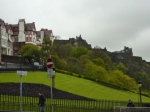
English: The Murder of David Rizzio, oil on panel, Depicts the killing of David Rizzio, secretary to Mary, Queen of Scots, by a group of nobles including Lord Darnley (the Queen’s husband), Lord Ruthven and the Earl of Morton (Photo credit: Wikipedia)
Today marks the 447th anniversary of David Rizzio’s murder in Mary Queen of Scots’ chamber at Holyrood Palace. Rizzio’s gruesome murder on March 9, 1566 marked a watershed in Mary Stuart’s reign in Scotland. One could call it the beginning of the end. Rizzio himself was not all that important except as a focal point for the Protestant Scottish nobles, led by Patrick, Lord Ruthven and aided and abetted by Mary’s husband Henry, Lord Darnley. The pact that sealed Rizzio’s death also sealed Darnley’s, though he could not have known it at the time. Rizzio’s death was the first in a series of incidents that destabilized Mary’s reign. Eighteen months later Mary was forced to abdicate in favor of her son James.
David Riccio di Pancalieri was born about 1533 to a well-known Piedmontese family somewhere near Turin, Italy. He was employed by the Duke of Savoy as a valet and musician and traveled with the Duke’s ambassador, Signor di Moretta to Scotland in 1561. He left the Duke’s employ to become one of Mary’s musicians – she needed a bass singer! This was not a particular sign of favor, according to John Guy in The True Life of Mary Stuart, Queen of Scots Mary “always” had musicians and minstrels on her payroll including five viol players, three lute players, several pipers and a shawm (early oboe) player. Most contemporary sources agree that David “Davy” Rizzio was ugly. Lady Fraser, author of Mary, Queen of Scots reports he “extremely ugly by the standards of the time, his face being considered ill-favored and his stature small and hunched.
How did Rizzio go from a singer in a “band” to Mary’s private secretary? Prior to 1564 Mary’s French secretary was Raulett, a cipherer who was also a retainer of the Guise family, her relations on her mother’s side. He was the only person beside Mary who had the key to the black box that contained her secret papers. In the run up to Mary’s marriage to Darnley, something must have happened to precipitate Raulett’s dismissal. She replaced him with David Rizzio – a move that seems odd in that he does not, on the face of it, appear to have been qualified.
Not long after Rizzio took over Mary’s French correspondence, she took a shine to her cousin Henry, Lord Darnley—the great-grandson of Henry VII through his daughter Margaret. By April 1565 she was crazy in love with Darnley, so much that the English Ambassador Randolph said she “whom ever before I esteemed so worthy, so wise, so honorable in all her doings” was now altered “to the utter contempt of her best subjects.” But as Darnley rose in Mary’s opinion he was falling out of favor with the Scots nobles who thought him arrogant and unpleasant.
Rizzio was riding high in favor of both Mary and Darnley in 1565. John Guy flat out says the two men were found in bed together. Clearly no one mentioned this to Mary, but Lady Fraser suggests the Four Maries and the majority of Scots nobles were against the match. Fraser notes that Rizzio was the only person who really supported her marriage to Darnley.
Mary’s marriage to Darnley was a disaster. It provoked the Scots nobles, notably Mary’s brother James Stewart, Earl of Moray into a rebellion, ostensibly because they feared the return of Catholicism to Scotland. Darnley was a member of the Lennox Stewart clan and there was a not unreasonable fear that clan’s power would overwhelm the others—in particular Moray and others who were de facto ousted from their closeness to Mary. Moray fled to England where he continued to stir the nobles.
Darnley expected to become King Henry by receiving the crown matrimonial. Even before the bloom was off their marriage, which didn’t take long, Mary shied from granting him that power. When Darnley took out his frustrations on Rizzio, who he began to feel had undue influence on Mary. It was not difficult for dissatisfied Protestant Lords to convince Darnley they could kill Rizzio and put him on the throne. They convinced Darnley that Mary was committing adultery with Rizzio and further suggested he was a spy for the Pope. (No evidence exists to suggest he was anything on than a singer who gained the trust of a sovereign.)
More than a dozen Scottish nobles conspired to kill Rizzio in the Queen’s presence. They ambushed Rizzio’s in Mary’s supper chamber – a small narrow room (I’ve seen it, amazingly tiny)—at Holyrood and demanded Mary hand him over. She refused and in response had a gun pointed at her — Mary was seven month’s pregnant at the time. They stabbed Rizzio more than 50 times before throwing him down the staircase, stripped of his jewels and clothes. He was buried within a few hours of his death somewhere in the grounds at Holyrood.
It is not clear to me how much real power and influence Rizzio had with Mary. He certainly died with a large sum of money (over £2,000, which is a lot for a man who made just £80/year), so perhaps he was taking bribes and peddling influence. It is clear he rose high, had few friends and far too many enemies.
Related articles
- March 9 in history (homepaddock.wordpress.com)
- Mary, Queen of Scots executed Chastelard 450 years ago today. Why? (thehistorylady.wordpress.com)
- Already Getting It Wrong: CW’s “Reign” about Mary, Queen of Scots (thehistorylady.wordpress.com)













